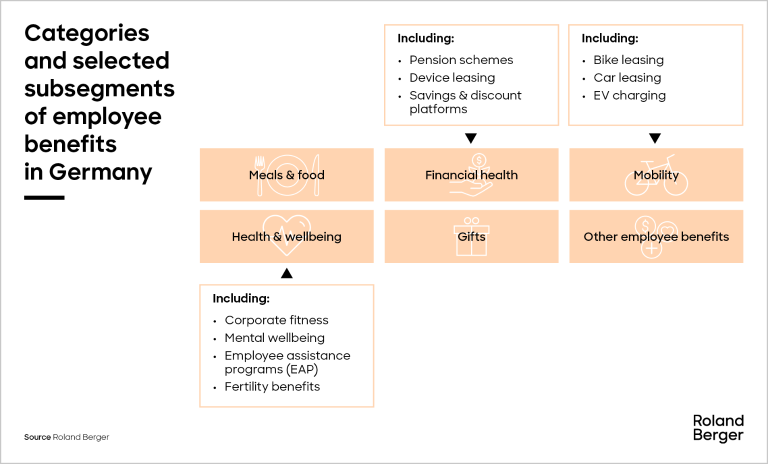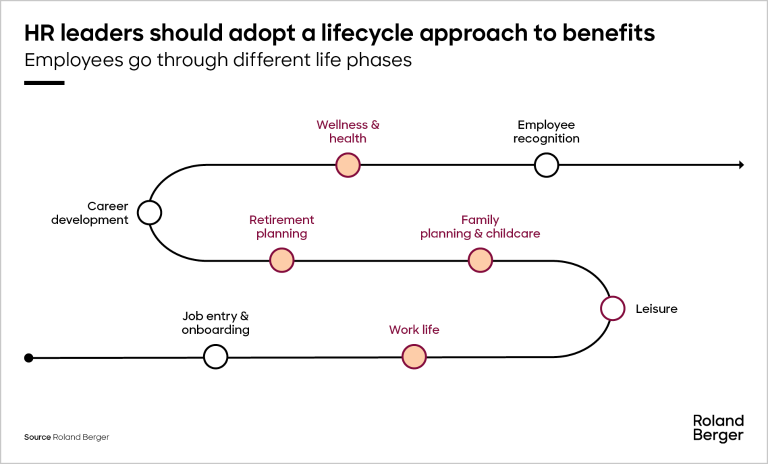Tailored solutions for companies and organizations. Unlock opportunities for your business.


Lost in the German employee benefits jungle? Key market trends 2025
By Fabian Neuen
Strategies for HR Leaders and employee benefits providers
The German employee benefits market has exploded in recent years, with segments such as bike leasing increasing fivefold since 2019. Many new segments have also emerged, from fitness classes to support with mental health. At the same time, employees' expectations and demand have grown, bringing added complexity to the picture. Both employers and benefits providers now struggle with the lack of transparency in the market, unsure which benefits employees really care about, what their competitors are doing and what trends are shaping the market. Our major new survey of more than 1,700 human resources (HR) leaders in Germany provides the answers to their questions and helps them find their way through the jungle.

We differentiate between six categories of employee benefits : meals and other food, mobility, health and wellbeing, financial health, gifts (including Sachbezug or benefits in kind) and other. These categories also comprise a number of distinct subsegments. For example, "health and wellbeing" includes corporate fitness, fertility benefits and employee assistance programs (EAPs). In the past, the six categories had little overlap as they cover very different products and services. But, increasingly, we are seeing a convergence of categories and subsegments, with benefits providers active in one segment expanding into other categories – to some extent an inevitable development, as benefits providers serve the same buying centers and compete for the same budgets.
"We expect demand for employee benefits in Germany to continue to grow, as employers need to enhance their branding and improve their recruitment and retention rates in times of labor shortage."
Tax benefits
The employee benefits market in Germany enjoys numerous tax subsidies, including the EUR 50 Sachbezug, EUR 600 tax free for health promotion and prevention measures, and regulations on meals and other food vouchers. But, surprisingly, our survey found that not all HR responsibles were aware of the tax regulations they could take advantage of. Indeed, more than one-quarter were unfamiliar with the health promotion regulation that can be used for fitness and mindfulness offerings, over 15 percent did not know about Germany's salary sacrifice scheme (the key driver behind the growth of bike and device leasing schemes in recent years) and five percent did not make any use of the Sachbezug tax benefit. Benefits providers would be well advised to educate their clients about these tax regulations and so help them reduce the cost of the benefits they offer their employees.
Different perspectives
The survey sheds important light on the attitudes of both employers and employees to benefits. Many companies try to reach as broad an audience as possible with their employee benefits, searching for what we might call "broad-spectrum antibiotics". As a result, they stick to the Big 5 – bike leasing, meals and other food, gifts (including Sachbezug cards and vouchers), fitness and EAPs. This is a good start. But a one-size-fits-all approach is inadequate when it comes to meeting the needs of different target groups.
Many companies are aware of this problem. They are currently extending the range of benefits they offer so that they cover support not only for work-related situations but also for employees' lives outside work and their long-term planning for retirement – what we refer to as a "lifecycle approach" to benefits. Over two-thirds of respondents think that this type of portfolio enlargement will become an important trend going forward. Other trends shaping the market include ensuring that the Big 5 benefits are in place at all companies, introducing either mental health benefits, care or family-building benefits (planned by 32 percent of respondents) and adding bAV company pension schemes to the benefits package offered to employees (13 percent of respondents).
Our recommendations for HR leaders and benefits providers
HR leaders are increasingly engaged in a war for talent – not just when it comes to recruiting staff but also for retaining them. It is more and more important that companies offer staff a stack of attractive benefits. However, the survey reveals that it is not purely the number of benefits that counts: Nine out of ten respondents say that offering five to ten "killer" benefits is more important than offering a broad spectrum of, say, 20 to 30 benefits that employees in any case do not make as much use of. In addition to the Big 5 benefits, we recommend choosing specific benefits that align with the firm's strategic goals and fit into their budgets while optimizing the value for their employees. For example, if the company wants to increase its number of female staff, it should offer benefits specifically targeting women. In addition, we recommend HR leaders to keep a close eye on overall costs and administrative efforts and make full use of any tax subsidies that are available, in order to show accountability and contribute to their company’s economic viability.
Benefit providers face a different set of challenges. We recommend that they move towards a multi-benefits approach, at the same time sharpening their go-to-market along three key dimensions: market segmentation, value proposition and sales channels. They need to find radical ways to cut the administrative burden on HR leaders, creating a smooth experience for them and employing digital solutions wherever possible. They should also consider demonstrating to clients how different benefits impact the workforce – something that almost three-quarters of HR leaders say they would like to understand better.
The survey was carried out in Q4/2024 by Roland Berger in collaboration with a consortium of employee benefits providers from different segments. The consortium consisted of, in alphabetical order, Deutsche Dienstrad (bike leasing), EGYM Wellpass (corporate fitness), MOOVE (prevention solutions), peaches (family-building and fertility benefits), Pluxee (meals and food, gifts) and the Bundesverband der PersonalManager*innen (BPM), a leading German HR professionals association. Each consortium partner circulated the 20-40 minute survey to its corporate clients or members.
Register now to access the full publication “Lost in the German employee benefits jungle? - Strategies for HR Leaders and benefits providers” and dive into the changing landscape of German employee benefits. Furthermore, you get regular news and updates directly in your inbox.






